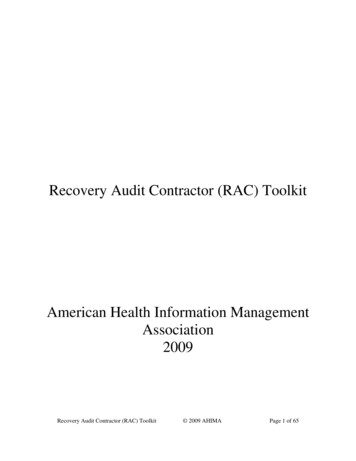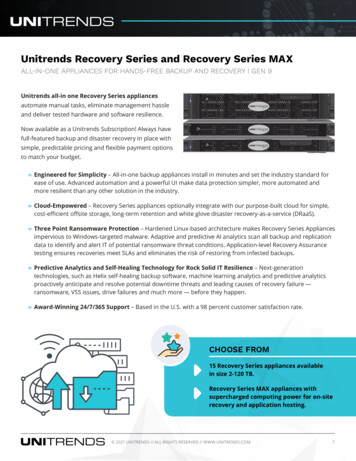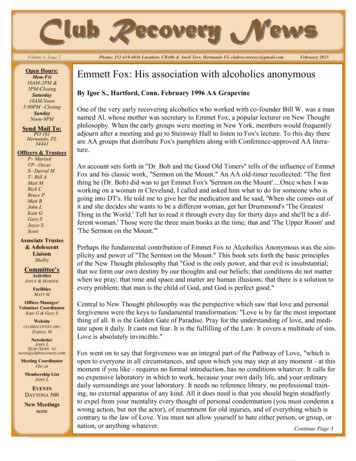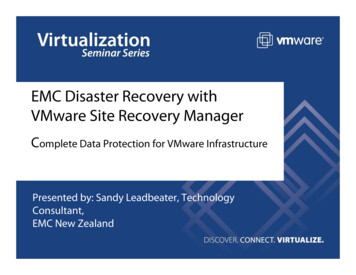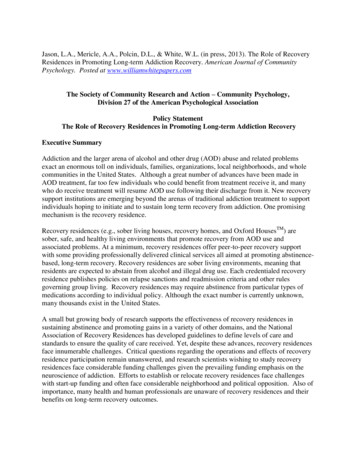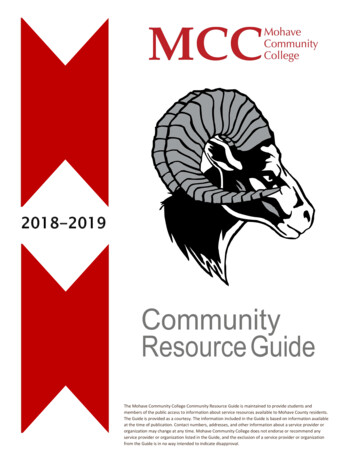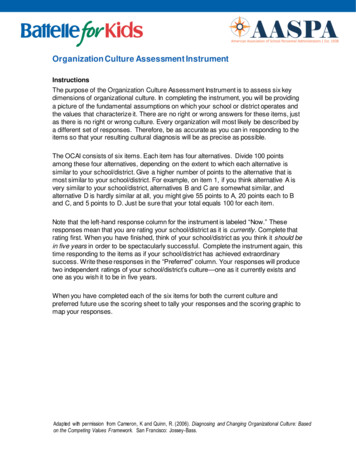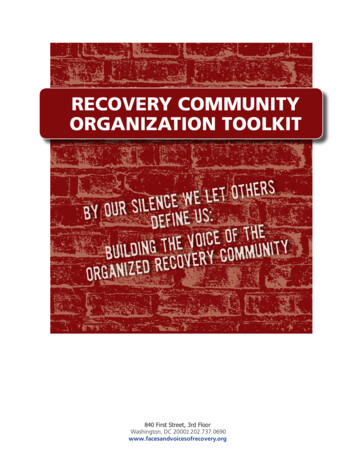
Transcription
RECOVERY COMMUNITYORGANIZATION TOOLKIT840 First Street, 3rd FloorWashington, DC 20002 202.737.0690www.facesandvoicesofrecovery.org
TABLE OF CONTENTSIntroductionRecovery Community OrganizationsI.Recovery Community Organizations: Core PrinciplesPage 5II. Recovery Community Organizations: Core StrategiesPage 7III. Recovery Community Organizations: ExamplesPage 10IV. Statewide recovery community organizations: Advocacy FocusPage 14V. Local Recovery Community OrganizationsPage 15VI. Learning from Experience: Keys to Successful RecoveryCommunity OrganizationsPage 16VII. Steps for Creating a Recovery Community OrganizationPage 19ACKNOWLEDGEMENTSThis Toolkit was developed with support from the Open Society Foundation and thegenerous donations of Faces & Voices of Recovery supporters.The Association of Recovery Community Organizations at Faces & Voices of Recoveryis a growing network of recovery community organizations across the nation. Moreinformation is available online at www.facesandvoicesofrecovery.org.January 2012PAGE 2
INTRODUCTIONWhen Faces & Voices of Recovery was founded in 2001, we stood on the shoulders of a rich history oforganized advocacy by the addiction recovery community – people in recovery, their families, friendsand allies.Marty Mann founded the National Council on Alcoholism almost 70 years ago to provide educationto raise the awareness of addiction and recovery across our society. Bill Wilson, the co-founder ofAlcoholics Anonymous, testified before Congress on the Hughes Act, envisioning a day when hundredsof AAs would fill the halls of Congress to demonstrate wellness and recovery. The late Senator HaroldHughes, a person in long-term recovery from addiction, founded the Society of Americans for Recoveryin 1991.The Society of Americans for Recovery (SOAR) is a grass-roots organization of concernedpeople from all walks of life. It is dedicated to the fundamental belief that alcoholic anddrug-dependent people and their families should have the same rights and privileges as allother people. It strives for a better understanding that treatment and recovery will reduceother health, social, and economic problems. Please join us to champion hope, justice, andopportunity for all whose lives are damaged by diseases of alcoholism and drug dependence.- Senator Harold Hughes, SOAR Founder and ChairmanFaces & Voices of Recovery was founded to provide focus for a growing advocacy force. Faces & Voicesis dedicated to organizing and mobilizing the over 20 million Americans in recovery from addictionto alcohol and other drugs, our families, friends and allies into recovery community organizationsand networks, to promote the right and resources to recover through advocacy, education, anddemonstrating the power and proof of long-term recovery.In many cases, recovery voices are marginalized and ineffective when the work is shouldered primarilyby lone individuals. As we know from the great social movements that precede ours, the public, policymakers, and the media can easily ignore individual voices. In fact, the reality of long-term recovery isoften overshadowed by media and public fascination with active addiction and popular myths supportedby stories of celebrities’ very public struggles with the dark side of addiction.Never doubt that a small group of thoughtful committed citizens can change the world;indeed, it’s the only thing that ever has.- Margaret MeadLong-term recovery from addiction to alcohol and other drugs is real for over 20 million Americans andthousands more get well every year, benefiting individuals and their families, the communities in whichwe live, work and go to school. There are as many different paths to recovery as there are differentpeople in recovery. Regardless of how people achieve recovery, they are the living proof that recoveryhappens and that there are real solutions to the problem of addiction to alcohol and other drugs.Times have changed. As the recovery community has unified around key priorities – to gain neededresources, embrace all pathways to recovery, innovate and provide services, and to end discriminationagainst people in or seeking recovery, new institutions have developed across the country.PAGE 3
Building strong recovery community organizations is one way to break feelings of isolation and shame, buildstrong relationships, and advocate for the solutions that we know work. Grassroots organizations developrecovery leaders, offer opportunities to express a collective voice and provide a forum for community service.Coming together to build a constituency of consequence means acting together to bring about positivechanges in community life through public action.Recovery community organizations are usually created by people in personal and/or family recovery inresponse to unmet needs in their communities. Often, they exist as voluntary advocacy and serviceorganizations for some time before they have funding to support their activities on a more formal basis. Theyhave learned that deliberate effort and regular adjustments to their plans and activities is required to strike abalance between building an organization that has the capacity to bring about real change and keeping anagenda focused on making a real difference in the lives of people in the recovery community.We know that when the recovery community works together – organizes – we have the ability to improve allof our lives.Many of us have carried a message of hope on a one-to-one basis; this new recovery movementcalls upon us to carry that message of hope to whole communities and the whole culture. It istime we stepped forward to shape this history with our stories, our time and our talents.- William White, recovery historianPAGE 4
RECOVERY COMMUNITY ORGANIZATIONSAcross the country, organizations that are independent, non-profit, led and governed by people in recovery,family members, friends and allies are mobilizing resources within and outside of the recovery community tomake it possible for the over 23 million Americans still struggling with addiction to find long-term recovery.Each organization has a mission that reflects the particular issues and concerns of their community.I. RECOVERY COMMUNITY ORGANIZATIONS: CORE PRINCIPLESAll groups share three core principles – recovery vision; authenticity of voice; and accountability to the recoverycommunity. Recovery visionRecovery community organizations focus on the reality of long-term recovery from addiction to alcoholand other drugs for over 20 million Americans and their families. The recovery community organization, itsleaders, and members have a singular goal: enhancing the quantity and quality of support available to peopleseeking and experiencing long-term recovery from addiction. Faces & Voices of Recovery envisions a day whenpublic and private policies have been implemented at the local, state, and federal levels to help individuals andfamilies get the help they need to recover, including access to effective care including treatment and peer andother recovery support services. Policies that discriminate against people in or seeking recovery will have beenreversed and removed.The focus is on the “solution” that involves mobilizing individual and community resources to promoterecovery, not a particular service or model of care. One of the founding principles of Faces & Voices ofRecovery is embracing all pathways to recovery. This principle is embodied in our Recovery Bill of Rights, astatement of a recovery vision and agenda. While recovery community organizations form strategic allianceswith like-minded partners, this vision is distinct from that of for example, human service agencies, faithbased and other community organizations, professional addiction treatment, and mental health treatment,and primary care providers. There are mission and vision statements from a variety of recovery communityorganizations in the Resource Section. Authenticity of voiceAuthenticity of voice means representing the interests of communities of recovery. A guiding principleis self-governance, mutual aid and support. Recovery community organizations are developing to servecommunities, with leadership by and for community members. Recovery community organizations havea majority of board members, managers, staff, and volunteers drawn from the community. This strongconnection is the source of a recovery community organization’s strength and ensures that the voice ofthe recovery community takes precedence over other interests.PAGE 5
By developing and nurturing strong grassroots networks, recovery community organizations develop leaders,offer opportunities for people to make their voices heard, and provide a forum for community service. Vibrantrecovery community organizations insure that the voices of people who have the lived experience of recovery,including family members, are heard and embraced and that the organization’s public education, advocacy,and recovery support services respond to the broadest spectrum of local recovery needs. Accountability to the recovery communityRecovery community organizations’ credibility and effectiveness depends on their ability to be accountableand responsive to the community they work in and with. In most cases, this means being an independent,stand-alone nonprofit organization, where they can manage their relationships with other organizations. Forexample, a recovery community organization may work closely with an association of treatment providers, aDrug Court, a Community Prevention Coalition or a hospital, but be independent of them in their governance.Independence allows a recovery community organization to bridge the gaps between the recovery communityand government agencies, the criminal justice system and the larger network of health and human servicesproviders. The recovery community organization’s real strength is drawn not from its links to other serviceorganizations but from the authentic voice of the individuals in the recovery community who relate to andactively support it.Recovery community organizations recruit and engage people in recovery, family members, friends and alliesto advocate on behalf of their own, identified interests. Wherever possible, recovery community organizationsuse something called “participatory processes” – different ways to involve both leaders and members – toweigh in on decisions on programming and policy. Recovery community organizations provide an organizedway for people to give back to their communities through volunteer and paid service to others seekingrecovery and work with allied organizations by offering recovery support services, advocating on commonpublic policy agendas, and broadening public understanding of the reality of recovery while remainingaccountable to the recovery community.PAGE 6
II. RECOVERY COMMUNITY ORGANIZATIONS: CORE STRATEGIESRecovery community organizations use three primary strategies to achieve their mission, fostering recoveryfocused and oriented values and communities. Each organization determines the mix and priority given toeach of these core strategies:1. Public education and awarenessPutting a face and a voice on recovery to educate the public, policy makers, service providers, and the mediaabout the reality of recovery offers hope and dispels myths and pessimism about the power and reality oflong-term addiction recovery. This strategy also draws attention to the social and policy barriers facing peoplein and seeking recovery.Growing numbers of individuals are speaking out publicly and sharing their experience as members of recoverycommunity organizations. They are using Faces & Voices recovery messaging to advocate while respecting theanonymity traditions of 12-step programs they may participate in – advocating with anonymity.Recovery community organizations have web sites, speakers bureaus, host educational forums at schools, hostTown Hall meetings, cable TV shows, and carry out many other public awareness activities. They are trainingpeople in recovery and family members as speakers and organizing public events, bringing recovery to thebroader community. One well-known national awareness effort is the annual September National RecoveryMonth observances. Groups across the nation and now worldwide organize walks, rallies and other events tofocus attention on the reality of recovery.2. Policy advocacyTo build recovery-oriented and supportive communities, recovery community organizations are addressing thepublic policy barriers that keep people from sustaining their recovery for the long haul. One consequence ofaddressing addiction as a criminal justice, not a public health crisis, has been the imposition of legal barrierson people with criminal records. Advocacy is aimed at ending the punishment and incarceration of people fortheir status as people with histories of addiction.These barriers make it much more difficult for people to get their lives back on track, get a job, obtainhousing, and reunite with their families and friends. Recovery community organizations are also engagedin advocacy at the local, state, and federal levels to promote policies and regulations in health insurance,program development, and resource allocation that make sense for the recovery community.3. Peer-based and other recovery support services and activitiesRecovery community organizations are innovating and delivering a variety of peer recovery support servicesand places to deliver those services, building a lasting physical presence in communities. Recovery coaching,telephone recovery support services, all-recovery meetings, and other services are being organized anddelivered by trained volunteers and/or paid staff. A growing network of recovery community centers arehome to these services as well as a place for community-wide sober social activities, workshops, meetings,and resource connections.PAGE 7
In addition to these three core strategies, recovery community organizations are also: Developing leaders, offering opportunities for people in recovery, family members, friends and alliesto express their collective voice, learn new skills and responsibilities, and provide a forum for communityservice.; Advocating for meaningful representation and voice for people in long-term addiction recoveryand family members on issues that affect their lives; Assessing needs related to the adequacy and quality of local treatment’ recovery support services,and other health and social services; Assessing strengths, assets, and resources available in the community to support recovery; Educating the public, policy makers, and service providers about the prevalence and multiplepathways of addiction recovery; Developing human and fiscal resources by expanding philanthropic and public support for addictiontreatment, recovery support services, and recovery advocacy and cultivating volunteerism within localcommunities of recovery; and Supporting research that illuminates effective strategies and the processes of long-term recoveryand establishes an evidence base for peer and community supports.PAGE 8
TYPES AND EXAMPLES OF RECOVERY COMMUNITY ORGANIZATIONSThis section describes different types of organizations with in-depth examples to illustrate the principles andstrategies that characterize recovery community organizations. There’s information on their history, includingthe context in which each was formed, and how they have evolved. The descriptions highlight some of theiractivities and shared principles of success.Recovery community organizations are organized in a variety of ways, depending on the needs of theirrespective communities and goals. Core principles of vision, authenticity of voice, and accountability areoften embodied but expressed in different ways. Some are statewide organizations, while others focuson serving the needs of local communities. In addition to these different geographic focuses, groupshave adopted different strategies. For example, the statewide Massachusetts Organization for AddictionRecovery (MOAR) focuses primarily on public awareness and advocacy and doesn’t provide peer recoverysupport services. Its membership is comprised of individuals throughout the state. Other recovery communityorganizations in Massachusetts provide peer recovery support services and turn to MOAR for its leadershipon state-level public policy advocacy.By contrast, the Recovery Alliance in El Paso, Texas focuses on public awareness and providing peer serviceslike recovery coaching and recovery housing to the El Paso recovery community. The Recovery Alliance is alsoone of the founding members of a new state wide recovery public awareness and advocacy organization,Texas Recovers! Texas Recovers! members are a confederation of local, community-based groups who havecome together to influence state policy.In some states, individual recovery advocates or local recovery community organizations are coming togetherto form state wide recovery community organizations. In Virginia, the recently formed Addiction RecoveryCouncil of Virginia (ARCVA) is a group of individuals, active in recovery advocacy, who are influencingVirginia’s policy towards a more productive recovery solution.ARCVA has organized a Recovery Caucus, modeled after the federal Addiction Treatment and RecoveryCaucus launched by former members of Congress Patrick Kennedy (D-RI) and Jim Ramstad (R-MN). Theyare working with the caucus to advocate for resources to support recovery community organizations indelivering services and supports that help achieve long-term recovery.Across the country, organizations and individuals are coming together at the state level to address andadvocate on policy issues in a unified way. They are advocating and working with state agencies includingAlcohol and Drug Administrations, Departments of Correction, Insurance Commissioners, as well aselected officials. With implementation of the Affordable Care Act, they are working with emerging HealthExchanges and other health and funding entities in their states.PAGE 9
III. RECOVERY COMMUNITY ORGANIZATIONS: EXAMPLESConnecticut Community for Addiction RecoveryBob Savage, CCAR’s founding Executive Director, began the Connecticut Community for Addiction Recovery(CCAR) in 1998 with initial financial support from the CT Department of Mental Health and AddictionServices, followed by a grant from the federal government’s Recovery Community Support Program (RCSP).He organized monthly Chapter meetings across the state that evolved into a statewide recovery communityorganization. His impetus for forming CCAR came from two questions that we on his mind while he wasworking for the state government:1. Where are the people in recovery when we are making critical decisions concerning them?2. Can the recovery community be organized to advocate for issues of importance to them?Originally, formed as an advocacy organization, CCAR members began asking to do more and a numberof them wanted to be of service. CCAR responded (with the support of RCSP’s switch from “support”to “services”) by developing peer-led services. Since 2002, CCAR has been developing and refining theseservices. One key service that CCAR has pioneered is peer telephone support that engages and supportsindividuals in early recovery through telephone check-ins and coaching.CCAR’s board has never formally defined membership. Its members are people who have agreed to be onits mailing list. The organization hasn’t developed a system of paid membership, but has an Individual GivingCampaign to encourage people to contribute their financial support.CCAR offers a number of ways for its members to be involved as volunteers – both as advocates and as peersdelivering services.CCAR’s Recovery Coach Academy has been a model for training recovery coaches nationwide. In 2012 alone,CCAR trained 997 recovery coaches from 27 states.Phil Valentine, CCAR’s current Executive Director, elaborates on some of the
organized advocacy by the addiction recovery community – people in recovery, their families, friends and allies. Marty Mann founded the National Council on Alcoholism almost 70 years ago to provide education to raise the awareness of addiction and recovery across our society. Bill Wilson, the co-founder of


